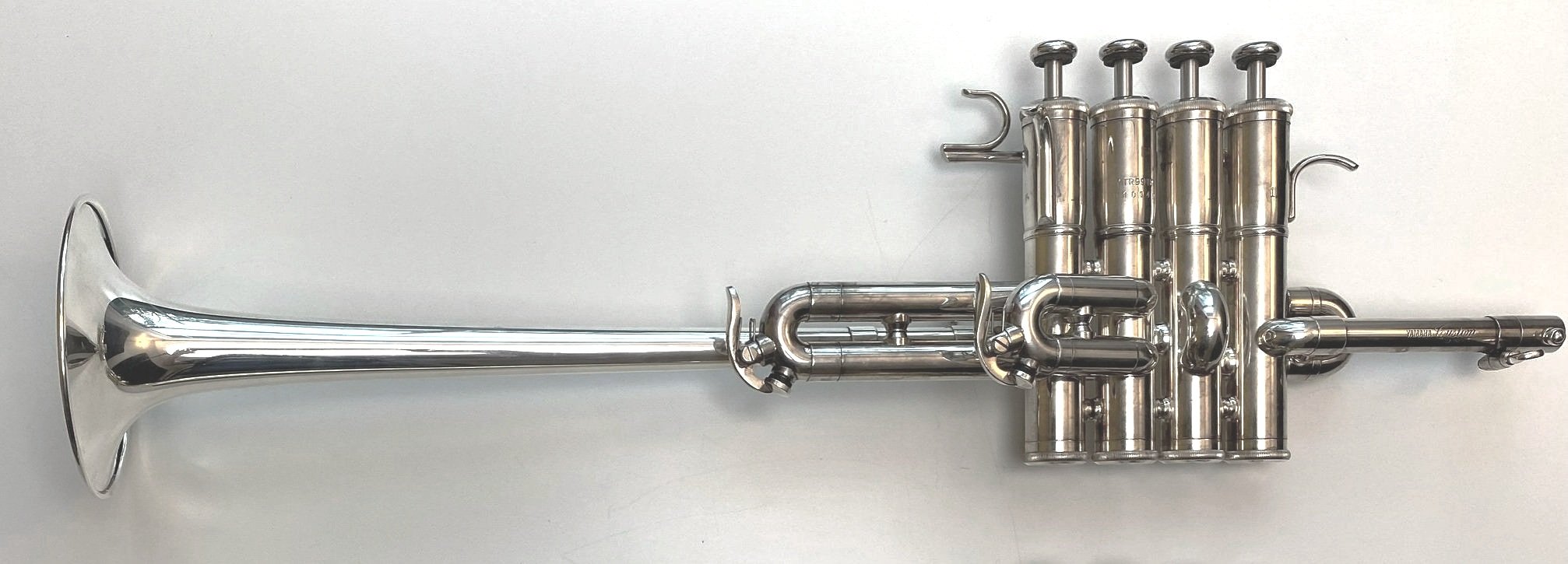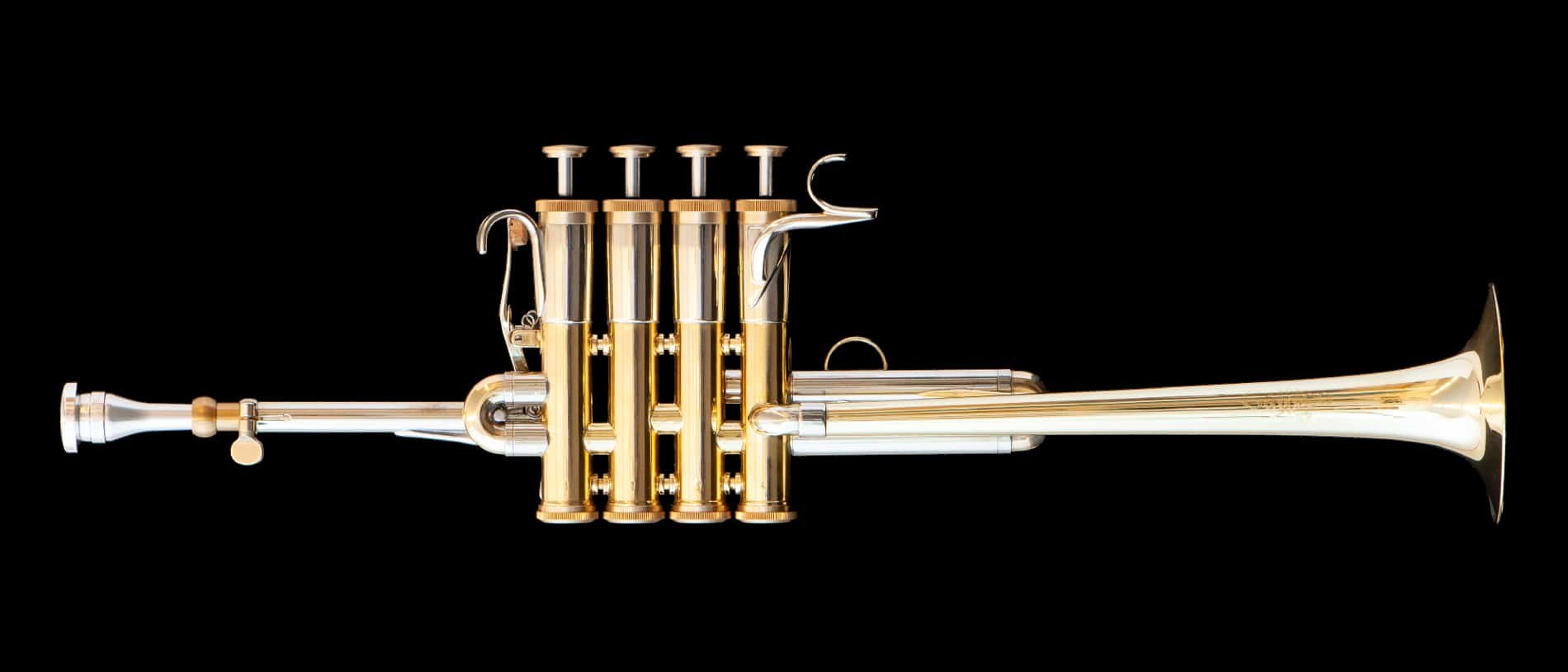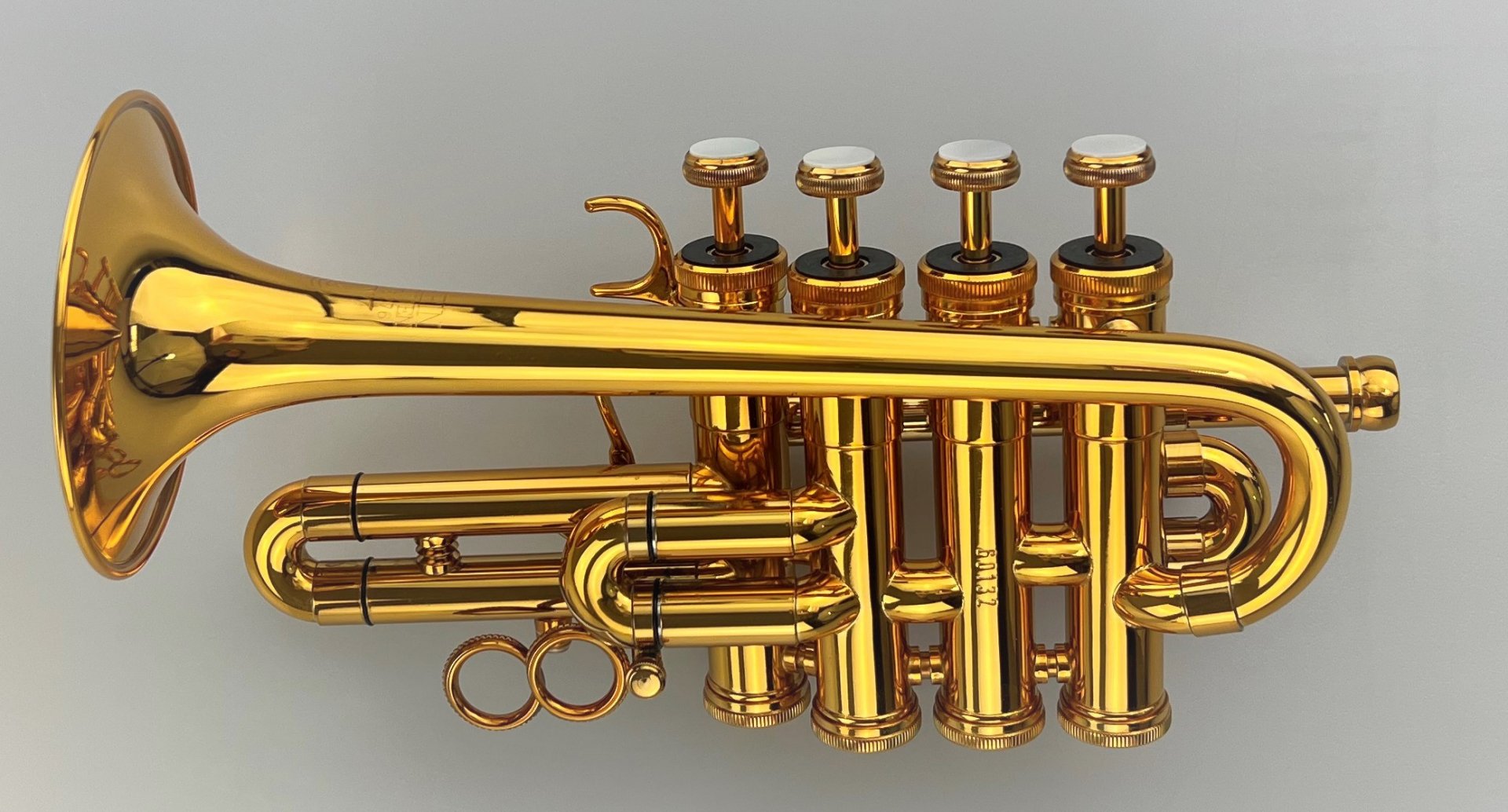
What is a C Piccolo Trumpet?
Probably most of you have seen a regular Bb/A Piccolo Trumpet before, which is a trumpet that is an octave higher and half the length of the standard Bb trumpet. C Piccolo trumpets are keyed a whole step higher than a Bb piccolo.
Bb Trumpet
Bb Piccolo Trumpet
C Piccolo Trumpet
Why Use a C Piccolo Trumpet?
The primary use case for a C piccolo trumpet is for the treacherous 2nd Brandenburg Concerto by Johann Sebastian Bach. This piece requires trumpeters to play in a very high register with both technical flair and a delicate style. Players such as Reinhold Friedrich, Edward Tarr, Ray Mase, David Washburn, and Caleb Hudson have all chosen to use C piccolo to play the Brandenburg instead of the Bb piccolo.
Reinhold Friedrich
Edward Tarr
David Washburn
Caleb Hudson
About the Brandenburg Concerto
(and why is it so high?)
The Brandenburg trumpet part was actually written about 300 years ago for the natural trumpet in F, which was quite a bit longer than a modern Bb trumpet. This was so long ago that trumpets didn’t have any valves, so in order to play scales or melodies you had to perform in the extreme upper register - literally in the modern day lead trumpet range! This is a true specialty called clarino trumpet playing - usually encompassing between the 8th and 24th harmonics on the natural trumpet.
The Harmonic Series
Today, there are a number of really good clarino players performing the Brandenburg on the F natural trumpet, but I would say almost everybody performs it on a Bb piccolo trumpet - which is the shortest, and highest instrument usually found in a professional trumpet player’s arsenal. Even though the Bb piccolo is literally less than half the length of the natural trumpet in F, the Bb piccolo’s valves and higher fundamental pitch makes this piece a lot more secure - but still, even with the help of that smaller instrument, it is *quite* challenging.
Natural Trumpet
Julian Zimmermann performing on Natural Trumpet
Why would you play C Piccolo Trumpet on Brandenburg?
J. S. Bach
Brandenburg Concerto No. 2 Mvt. I (Trumpet in F) - the HIGH NOTE SPOT with High A’s on Bb Picc
Fingerings in F Major - Playing the Brandenburg on C piccolo puts the fingerings in F major, which is super familiar to all of us used to playing on the A piccolo trumpet for the countless Baroque pieces set in D major. It also helps with the fingerings, intonation, and transposition compared to playing in G major on the Bb picc.
Easier Trills - There are several trills and technical passages in the Brandenburg that are just easier to play in F - like the trill in the opening of the first movement. When you’re on a Bb piccolo, the opening has a slightly awkward D to E trill, while on C piccolo it’s a simple C to D trill which lets you use the common trick of trilling open to 4th valve.
Better High Notes - Yes, the C piccolo is pitched higher than a Bb piccolo, but I wouldn’t actually say the notes are physically easier to play as a result of this. You still have to vibrate your lips to produce the high notes, but the specific high notes found in the Brandenburg are a little easier in the key of F. The most sweated over passage in this piece is usually in the second half of the first movement, which has three high concert Gs in the space of only seven measures after you’ve already been playing continuously for several minutes. On the Bb picc, those are high As, and people use various strategies to help play nail them, including different fingering options as well as removing the fourth valve slide and playing them 4th valve only. Some folks even use a small secondary bell called a Brandenburg bell to make this note sound more like the rest of them. On the C piccolo however, that note is just an open high G. Don’t get me wrong, it’s still super high, but it’s definitely easier to just “pick off” compared to a high A on the Bb picc.
Balance and Timbre - Believe it or not, the Brandenburg is NOT actually a trumpet solo, but a concerto for FOUR musicians - trumpet, flute, oboe, and violin, all in front of a small group of string players and harpsichord. So, even though the trumpet part is high and difficult, the challenge is to somehow play it while playing “nice” with a bunch of comparatively quiet instruments. The C piccolo makes balancing with them easier due to it’s lighter, glassier timbre, which helps you play with a nuance and delicacy more like the other soloists.
Feedback - Some of the most common C Piccolo trumpets come with a herald bell design (like the Yamaha 991 and 9910 and Schilke C5-4). I feel like the bell being a little further away helps reduce the amount of your own sound you hear while playing, which give you a more accurate picture of how your sound is blending and balancing with the other soloists.
Herald Style Bells -
Yamaha 9910 C Piccolo (top)
Yamaha 991 C Piccolo (bottom)
A “Brandenburg Bell” on a Schilke P5-4
(Photo credit: Michael Arndt, Middle Tennesee State University)
Herald Style bells put the bell VERY far from your ears, making it easier to balance with other soloists! (Model: Alex Wilborn)
Models of C Piccolo Trumpets
-

Schilke C5-4 C Piccolo
For the fans of the Schilke P5-4 Bb/A Piccolo!
Features:
.450” bore size
Tunable cornet shank leadpipe
Tunable herald bell
-

Egger/Galileo C Piccolo
Designed with Reinhold Friedrich!
Features:
.441” bore size
Tunable cornet shank leadpipe
Fixed herald bell (4.13” diameter)
Tuning aids come pre-installed, including a 1st valve trigger and 3rd slide ring
-
Scherzer 8110 C Piccolo
For the fans of the Scherzer 8111 Bb/A Piccolo!
Features:
.412” bore size
Tunable trumpet shank leadpipe
Fixed bell (3.937” diameter)
No right hand pinky ring :(
-

Thein Piston C Piccolo
This is an updated design from 2023. You’ll see an older version in my YouTube video from 2022.
Features:
.453” bore size
Tunable trumpet shank leadpipe
Fixed bell (3.5” diameter)
4th valve trigger
-

Thein Rotary C Piccolo
Thein, always the overachievers, actually offer 2 C piccolo trumpets - piston and rotary valve versions.
Features:
.431” bore size
Tunable trumpet shank leadpipe
Fixed bell (3.74” diameter)
4th valve slide trigger
-

Kromat C Piccolo
The most creative design of the bunch!
Features:
Tunable trumpet shank leadpipe
3+1 valve configuration - it has 3 piston valves with a 4th rotor valve extension on the 3rd slide (like the Yamaha 9825 Bb/A Piccolo)
-

Spada C Piccolo
The C piccolo shrouded in mystery!
Features:Tunable leadpipe (not sure if cornet or trumpet shank)
Fixed “quasi” herald style bell
That is literally all they say on their website.
-

Yamaha 918 C Piccolo (discontinued)
The first Yamaha C Piccolo!
Features:.450” bore size
Fixed leadpipe
Tunable bell
-

Yamaha 991 C Piccolo (discontinued)
Made from 1975-1981
Features:
.445” Bore Size
Small, curved trumpet shank leadpipe
Tunable herald bell (3.75” diameter)
-

Yamaha 9910 C/B-flat/A Piccolo (discontinued)
Only made for a short period in the 1980’s
Features:
.445” bore size
Tunable trumpet shank leadpipe
Tunable herald bell (4” diameter)
Key changes using bell extensions and a longer set of 1st and 3rd slides used for the Bb/A sides
-

Blackburn C/B-flat Piccolo (discontinued)
The above photo is from David Hickman’s book Trumpet Pedagogy. For many years, Blackburn offered both C/Bb and A/G piccolos instead of the standard Bb/A configuration, but now they only offer the Bb/A.
-

Scherbaum & Göttner C Piccolo (Discontinued)
Developed in collaboration with Prof. Adolf Scherbaum (1909-2000)
Features:.449” bore size
tunable leadpipe
Fixed bell (3.7” diameter)
SUPER quick bell flare
Downsides of Using a C Piccolo
1. Only a few use cases - Besides the Brandenburg, there aren’t *a ton* of situations I can think of where a C picc would be a better choice than a typical Bb/A. Sure, there’s little things here and there, like maybe the picc part in The Wound Dresser by John Adams which asks for C piccolo, but I would guess that’s a transposition and not an actual request for C picc to be used. You could also maybe try it on the high trumpet bits at the end of Bolero or Petrouchka, but again, these are all licks that are arguably going to be basically just as easy on the Bb picc. When doing the research for this post, I asked famed trumpet performer, teacher, and C piccolo user Mr. Ray Mase, if he ever found other occasions to use it. He said, “Well, not often…” but he told me he has used it on some contemporary pieces over the years and once even broke it out for a studio recording gig for a jingle for a Liberty Coins ad back in the 80s.
Mr. Mase’s (composer signed) copy of his Liberty Coins trumpet part.
Professor Raymond Mase
US Liberty Coins Advertisement - follow along with the music and you’ll hear Mr. Mase KILLING on C Piccolo trumpet!
2. C Piccolos just play differently - If you are used to playing a Bb/A piccolo trumpet, it still takes some adjustment to get comfortable on the C piccolo. It’s sort of like the adjustment needed for switching between a regular C trumpet and the smaller Eb/D trumpet. Even though these trumpets are only a step or two apart, you’ll definitely need to spend some time on the C piccolo just to get reasonably comfortable playing it. Not only is the blow and resistance different, the intonation tendencies can be challenging to learn and adjust to. I even had to learn a fun new fingering for Low C - 1+4 - since the slot of the open low C both of my C piccs is so wide and unpredictable.
Piccolo Trumpet in C part from “The Wound Dresser” by John Adams
“Small” Trumpet in D part for Ravel’s “Bolero”
Trumpet part (in C) from the end of Stravinsky’s Petrouchka - an excerpt called “Petrouchka’s Ghost”
Even Higher Trumpets!?
OK trumpet nerds, you might be wondering - are there any trumpets HIGHER pitched than a C piccolo?
WELL... According to Ed Tarr, Schilke did once get an order for a D piccolo trumpet, which would be a whole step higher than the C piccolo - but I’m not sure it was ever actually made. Apparently, the biggest difficulty in making valved trumpets THIS short, besides the various acoustical challenges, is how short the 2nd valve slide needs to be. You can see on many of the C piccolos pictured above that the 2nd valve slide is very short, but apparently even these are a compromise length since it’s so tricky to make it short enough.
Trent Hamilton’s “Super Piccolo Trumpet”
This monstrosity was made by Trent Hamilton. Somehow, it is a whole two octaves higher than a standard Bb trumpet. There are definitely some compromises involved here, to get around the 2nd valve length thing I mentioned above, but I love the effort!
Mel Broiles and the “Zarathustra Trumpet”
The prize for the smallest trumpet I’ve seen goes to this crazy little thing. Once owned by the famed Metropolitan Opera principal trumpeter Mel Broiles, this trumpet is literally a horn taken off the handlebar of a bicycle, with a trumpet mouthpiece plugged into it. I mean, yeah, it is technically smaller than a C piccolo, but since it doesn’t have any valves it’s not going to be much help in most real life musical situations, besides finally nailing that high C in Zarathustra. ;)
Check out my original 2022 video all about the C Piccolo Trumpet!



